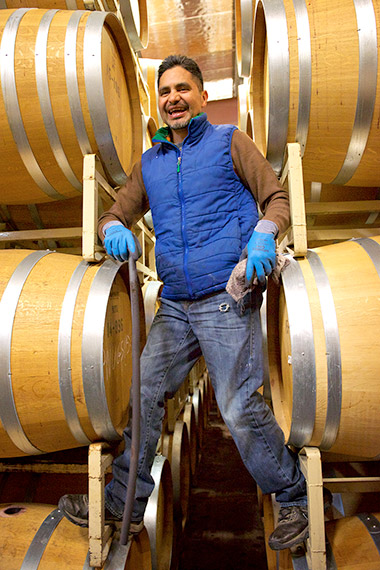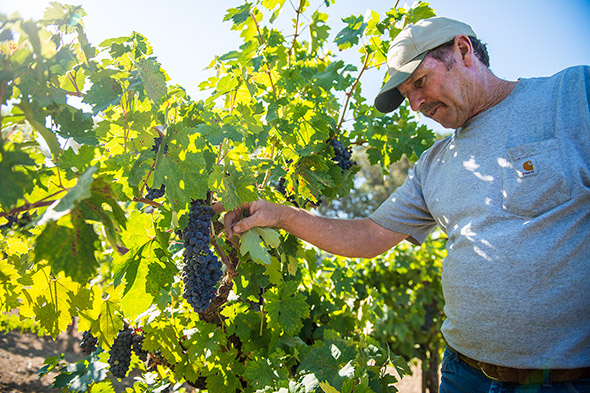Petite Sirah—AKA Durif or Pets locally—was a spontaneous cross between Syrah and Peloursin, discovered in 1880 by Dr. François Durif, a grape botanist at the University of Montpellier in southern France. It was brought to California in 1884 and by 1890, articles in the
Livermore Herald stated that Concanon Winery tended 540 acres of vines in Alameda County and even shipped Petite Sirah vines to vineyards in Mexico. In the last decade of the 19th century, phylloxera destroyed most of the true Syrah vines in California and by 1900, Petite Sirah had become a popular variety in California although it was virtually unknown in France.

![[left]](/images/buttons/arrow_left.gif) Ulises topping barrels. Wine evaporates when stored in barrels so we top each barrel with additional wine once a month to avoid excess exposure to oxygen. If cellar conditions are damp, much of the evaporation can be alcohol; if the cellar is dry, the evaporation favors water rather than alcohol. Navarro's Petite Sirah is aged in seasoned French oak barrels for almost two years so topping losses can be significant.
Ulises topping barrels. Wine evaporates when stored in barrels so we top each barrel with additional wine once a month to avoid excess exposure to oxygen. If cellar conditions are damp, much of the evaporation can be alcohol; if the cellar is dry, the evaporation favors water rather than alcohol. Navarro's Petite Sirah is aged in seasoned French oak barrels for almost two years so topping losses can be significant.
 Al Tollini inspecting black fruit on his heritage vines.
Al Tollini inspecting black fruit on his heritage vines. ![[above]](/images/buttons/arrow_up.gif)
Its popularity in California soared during prohibition as the grapes were highly colored with tough skins and could be successfully shipped by railway to home winemakers on the east coast; by 1930, plantings of the variety in California had increased to over 4,500 acres. There are many of these old Petite Sirah vineyards still being farmed in Mendocino, Sonoma and Napa counties; DNA evidence shows that about 90% of these vines are true Petite Sirah and the remainder are usually Peloursin—the mother of Durif. The grapes for Navarro's Petite Sirah were grown on vines carefully tended by Al Tollini, whose grandfather planted the vineyard over 80 years ago; undoubtedly, some Peloursin vines are interplanted with the Pets. The 2015 grapes were destemmed into an open-top fermentor and we punched down the must by hand twice a day to keep the tannins supple. After aging two years in seasoned French oak barrels and another two years in bottle, the wine is full bodied with flavors of dried plum, cherry and hints of black currant tea.
Gold Medal winner. Best of Class.

